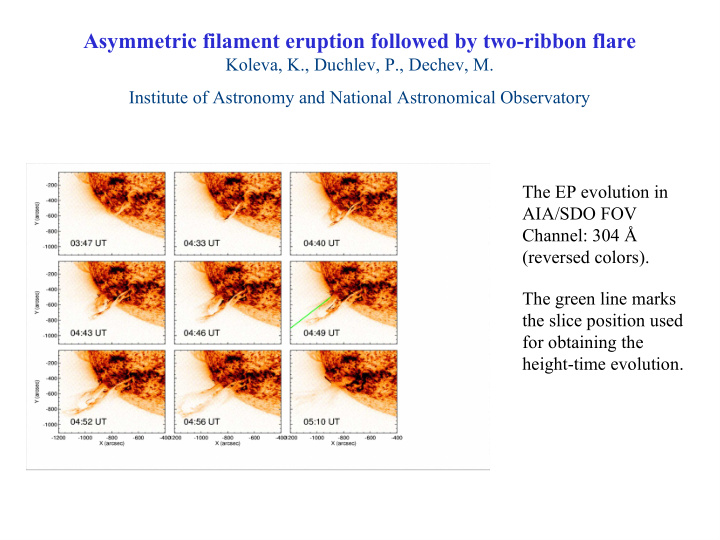



Asymmetric filament eruption followed by two-ribbon flare Koleva, K., Duchlev, P., Dechev, M. Institute of Astronomy and National Astronomical Observatory The EP evolution in AIA/SDO FOV Channel: 304 Å (reversed colors). The green line marks the slice position used for obtaining the height-time evolution.
Prominence kinematics: Time-distance diagram Height-time profile of prominence evolution (top) and eruption velocities and acceleration (bottom). The start time is: 2014-Nov-01 03:00UT.
Solar two ribbon flare kinematics: Goes class: C2.7; Position: S22E52 Two ribbons flare as viewed in AIA 304 Å, The distance between flare ribbons 171 Å, 1600 Å and 131 Å channels at (top panel) and the separation temperature formation: log (T) = 4.7, 5.8, velocity (bottom panel): 5.0 and 7.2, respectively.
CME: The prominence eruption was associated with a fast partial halo CME, which first appearance in LASCO/C2 FOV was at about 05:00 UT. CME properties: Position angle: 74° degrees; linear speed: 1624 km/s ; acceleration: 7.3 m/s 2 Height-time evolution of EP and CME evolution sample in associated CME (top panel) and Goes LASCO C2 field of view. SXR flux (bottom panel). The start time is 03:00 UT. The time of flare peak is marked with black arrow.
Summary The asymmetric EP on 2014 Nov 01 slowly rose with velocities from 1.2 km/s to ~18 km/s and then it underwent rapid acceleration, rising with velocities ranging from 20 km/s up to 468 km/s in the AIA/SDO field of view. The two-ribbon flare underneath the EP most probably occurred due to reconnection processes in the coronal magnetic field in the wake of the prominence eruption. The ribbons' separation kinematics clearly shows two stages: first a deceleration phase with velocities falling from 35 km/s to several km/s and a second phase, which exhibits very slow velocity of 1.4 km/s. The EP produces a very fast halo CME, which propagates with velocity of 1624 km/ s. The CME core formed by the EP can be traced up to 16 solar radii in the SOHO/LASCO C3 field of view.
Recommend
More recommend